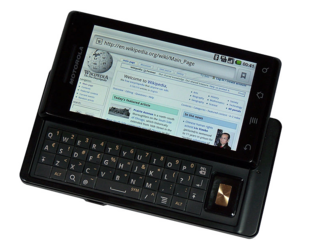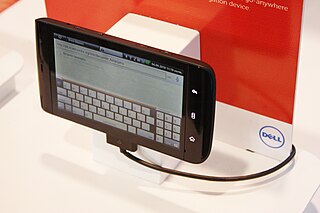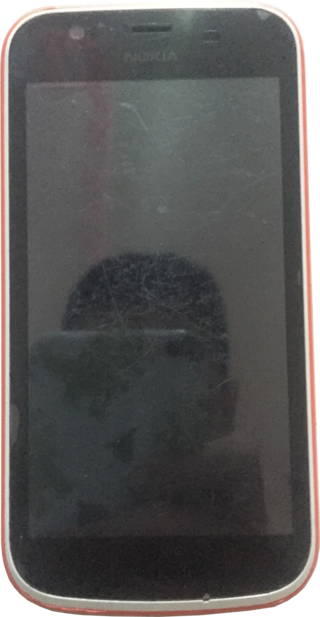Related Research Articles
Iridium Communications Inc. is a publicly traded American company headquartered in McLean, Virginia, United States. Iridium operates the Iridium satellite constellation, a system of 75 satellites: 66 are active satellites and the remaining nine function as in-orbit spares. Iridium Satellites are used for worldwide voice and data communication from handheld satellite phones, satellite messenger communication devices and integrated transceivers, as well as for two-way satellite messaging service from supported Android smartphones. The nearly polar orbit and communication between satellites via inter-satellite links provide global service availability.

A smartphone is a portable computer device that combines mobile telephone functions and personal computing functions into one unit. They are distinguished from older-design feature phones by their more advanced hardware capabilities and extensive mobile operating systems, which facilitate wider software, access to the internet, and multimedia functionality, alongside core phone functions such as voice calls and text messaging. Smartphones typically contain a number of metal–oxide–semiconductor (MOS) integrated circuit (IC) chips, include various sensors that can be leveraged by pre-installed and third-party software, and support wireless communication protocols. More recently, smartphone manufacturers have begun to integrate satellite messaging connectivity and satellite emergency services into devices for use in remote regions where there is no reliable cellular network.
Sony Mobile Communications Inc. was a multinational telecommunications company founded on October 1, 2001, as a joint venture between Sony Corporation and Ericsson. It was originally incorporated as Sony Ericsson Mobile Communications, and headquartered in London, England, until Sony acquired Ericsson's share in the venture on February 16, 2012. On April 1, 2021, Sony integrated its electronics businesses including Sony Mobile into one company called Sony Corporation.

Near-field communication (NFC) is a set of communication protocols that enables communication between two electronic devices over a distance of 4 cm (1.57 in) or less. NFC offers a low-speed connection through a simple setup that can be used to bootstrap more capable wireless connections. Like other "proximity card" technologies, NFC is based on inductive coupling between two antennas present on NFC-enabled devices—for example a smartphone and a printer—communicating in one or both directions, using a frequency of 13.56 MHz in the globally available unlicensed radio frequency ISM band using the ISO/IEC 18000-3 air interface standard at data rates ranging from 106 to 848 kbit/s.

A camera phone is a mobile phone which is able to capture photographs and often record video using one or more built-in digital cameras. It can also send the resulting image wirelessly and conveniently. The first commercial phone with color camera was the Kyocera Visual Phone VP-210, released in Japan in May 1999.
Truphone is a GSMA-accredited global mobile network that operates its service internationally. The company is headquartered in London and has offices in ten other countries, being spread across four continents.
Android is a mobile operating system based on a modified version of the Linux kernel and other open-source software, designed primarily for touchscreen mobile devices such as smartphones and tablets. Android is developed by a consortium of developers known as the Open Handset Alliance, though its most widely used version is primarily developed by Google. It was unveiled in November 2007, with the first commercial Android device, the HTC Dream, being launched in September 2008.
A mobile operating system is an operating system for smartphones, tablets, smartwatches, smartglasses, or other non-laptop personal mobile computing devices. While computers such as typical/mobile laptops are "mobile", the operating systems used on them are generally not considered mobile ones, as they were originally designed for desktop computers that historically did not have or need specific mobile features. This line distinguishing mobile and other forms has become blurred in recent years, due to the fact that newer devices have become smaller and more mobile unlike hardware of the past. Key notabilities blurring this line are the introduction of tablet computers and light-weight laptops and the hybridization of the two in 2-in-1 PCs.

BBM, also known by its full name BlackBerry Messenger, was a consumer-oriented proprietary mobile instant messenger and videotelephony application service originally developed by BlackBerry Limited and later briefly by Indonesian company Emtek under licence. Initially it was included and offered on BlackBerry devices before it was expanded cross-platform. BBM was shut down on 31 May 2019; the company since continues to offer the paid enterprise edition, BBM Enterprise.

The Motorola Droid is an Internet and multimedia-enabled smartphone designed by Motorola, which runs Google's Android operating system. The Droid had been publicized under the codenames Sholes and Tao and the model number A855. In Latin America and Europe, the model number is A853 (Milestone), and in Mexico, the model number is A854 (Motoroi). Due to the ambiguity with newer phones with similar names, it is also commonly known as the DROID 1. The brand name Droid is a trademark of Lucasfilm licensed to Verizon Wireless.

Dell Streak 5 is a smartphone/tablet hybrid ("phablet") from Dell that uses the Android operating system, released in 2010. It comes with a 5-inch (13 cm) capacitive touchscreen and two cameras, a 5MP one with dual-LED flash on the back and a VGA-resolution one on the front for video calling; both are capable of video.

The Motorola Backflip is a touchscreen smartphone released to the U.S. for AT&T on March 7, 2010, and for other countries on Telus and Optus. It runs the open source Google Android software.

The LG Optimus One is an entry-level series of touch-screen smartphones manufactured by LG Electronics, Inc. It was released running the Android 2.2 Froyo, and later LG released software to upgrade it to Android 2.3 Gingerbread. Although the basic physical form factor of each variant is the same, the variants have differences in hard button shape and layout, the form of the metal side bezel and the user interfaces added by LG or various carriers. Versions of the Optimus One exist that operate on various frequency bands and either GSM or CDMA-based network protocols. They may also feature one or more variations in hardware, such as a faster processor, the addition of a physical keyboard, a modem with higher theoretical speeds, or a better digital camera.
Carrier IQ was a privately owned mobile software company founded in 2005 in Sunnyvale, California. It provided diagnostic analysis of smartphones to the wireless industry via the installation of software on the user's phone, typically in a manner that cannot be removed without rooting the phone. The company says that its software is deployed in over 150 million devices worldwide.

Redmi is a subsidiary company owned by the Chinese electronics company Xiaomi. It was first announced in July 2013 as a budget smartphone line, and became a separate sub-brand of Xiaomi in 2019 with entry-level and mid-range devices, while Xiaomi itself produces upper-range and flagship Xiaomi phones. Redmi phones use Xiaomi's MIUI user interface on top of Android. Models are divided into the entry-level Redmi, the mid-range Redmi Note, and the high-end Redmi K. The unrelated Mi A Android One series is positioned in the same market segment as Redmi devices, despite being part of the upper-range Xiaomi Mi lineup. The most significant difference from other Xiaomi smartphones is that Redmi uses less expensive components, allowing lower prices while retaining good specifications. In August 2014, The Wall Street Journal reported that in the second quarter of the 2014 fiscal year, Xiaomi had a market share of 14% of the China smartphone market; Redmi sales were attributed as a contributing factor toward this ranking.
Nokia, or HMD Global branded as Nokia Mobile, is a Finnish mobile phone manufacturer. The company is made up of the mobile phone business that Nokia sold to Microsoft in 2014, then bought back in 2016. HMD began marketing Nokia-branded smartphones and feature phones on 1 December 2016. The company has exclusive rights to the Nokia brand for mobile phones through a licensing agreement. The HMD brand is only used for corporate purposes and does not appear in advertising, whereas the name "Nokia Mobile" is used on social media.

The Google Assistant is a virtual assistant software application developed by Google that is primarily available on mobile and home automation devices. Based on artificial intelligence, The Google Assistant can engage in two-way conversations, unlike the company's previous virtual assistant, Google Now.

The Nokia 1 is a Nokia-branded budget Android Go smartphone, developed by HMD Global. It was launched at the Mobile World Congress 2018, in Barcelona, Spain on 25 February 2018. This device, along with the Nokia 8 Sirocco, completes the lineup of Nokia-branded Android devices. The phone also has separately sold removable back covers marketed as Xpress-on, a trade-name that first appeared on the Nokia 5110. This was the first time the Xpress-on name was used since the Nokia Lumia 710 in 2012.

The Oppo R17 is a line of Android phablets manufactured by Oppo. It comprises the Oppo R17, R17 Pro, and R17 Neo, which were officially unveiled on August 23, 2018 for the Chinese market. The R17 was the first smartphone to receive Oppo's "Hyper Boost Acceleration Engine," which provides improvements in gaming performance, system, and app usage.
Realme is a Chinese consumer electronics manufacturer based in Shenzhen, Guangdong. It was founded by Li Bingzhong on May 4, 2018, who was a former vice president of Oppo. Starting originally as a sub-brand of Oppo, Realme eventually ventured as its own brand. Realme then became the fastest-growing 5G smartphone brand in Q3 2021.
References
- ↑ "The Netphone - Smart Communications". smart.com.ph. Archived from the original on 2018-04-06. Retrieved 2018-02-11.
- 1 2 3 Olandes, Abe (5 September 2011). "Smart Netphone 701 review". Yugatech. Archived from the original on 6 April 2018. Retrieved 11 February 2018.
- 1 2 "Smart Netphone Review - www.unbox.ph". www.unbox.ph. Archived from the original on 2015-08-29. Retrieved 2018-02-11.